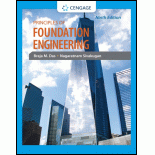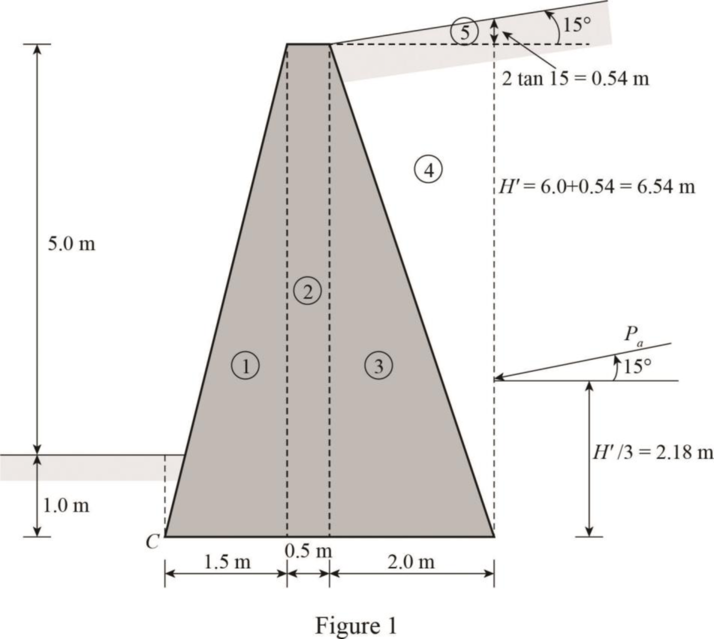
Find the factor of safety against overturning, sliding, and bearing capacity.
Answer to Problem 17.1P
The factor of safety against overturning is
The factor of safety against sliding is
The factor of safety against bearing capacity failure is
Explanation of Solution
Given information:
The frictional angle of backfill
Unit weight of backfill
The backfill makes an angle of
Unit weight of concrete is
Calculation:
Calculate the weight and moment arms by dividing the retaining wall and soil regions interest into rectangles and triangles.
Show the rectangles and triangles divided in the structure as in Figure 1.

Refer Table 16.3, “Values of
The value of active earth pressure
From Figure 1.
The total height from base is
Find the total force per unit length of the wall
Substitute
Find the horizontal force
Substitute
Find the vertical force
Substitute
Find the weight and moment about C for the sections as in Table 1.
| Section |
Weight |
Moment arm from C (m) |
Moment about C |
| 1 | 1 | 108 | |
| 2 | 1.75 | 126 | |
| 3 | 2.67 | 384.5 | |
| 4 | 3.33 | 369.6 | |
| 5 | 3.33 | 33.3 | |
| 4 | 121.6 | ||
Analyze the stability with respect to overturning:
Find the overturning moment
Substitute
From Table 1, the value of resisting moment is
Find the factor of safety against overturning using the relation:
Substitute
Therefore, the factor of safety against overturning is
Find the passive earth pressure coefficient
Substitute
Find the passive force
Here, D is the depth of retaining wall below the soil.
Substitute
Find the value of
Substitute
Find the factor of safety against sliding using the relation:
Substitute
Therefore, the factor of safety against sliding is
Analyze the stability with respect to bearing capacity failure:
Find the eccentricity (e) of the resulting force using the relation:
Here, B is the base width of the retaining wall.
Substitute 4 m for B,
The value of
The calculated eccentricity value is less than the value of
Find the maximum value of pressure at
Substitute
Find the ultimate bearing capacity
Find the value of
Substitute
Find the value of
Substitute 4 m for B and 0.116 m for e.
Refer Table 6.2, “Bearing capacity factors” in the textbook.
The value of
Find the depth factor
Substitute
For
Find the inclination of load on the foundation with respect to vertical
Substitute
Find the inclination factor
Substitute
Find the inclination factor
Substitute
Substitute
Find the factor of safety against bearing capacity failure using the relation:
Substitute
Therefore, the factor of safety against bearing capacity failure is
Want to see more full solutions like this?
Chapter 17 Solutions
Principles of Foundation Engineering
- Problem 10 The backfill and foundation sand have unit weight of y = 135 pcf and Ø = 38. The backfill has a slope of 17 degrees and resultant force Ra acts parallel to the backfill slope as shown below. The friction angle between the base of the wall and the foundation sand is 8-2/30. The factor of safety against sliding and overturning, respectively, are most nearly (neglect passive pressure): W=5,531 lb/ft 17° Ra=2576 lb/ft 9.0 12.0' 17 5.54 2.5 1.5 A. 1.1 and 2.8 B. 1.3 and 3.8 C. 1.3 and 2.8 1.1 and 3.8 ABCD 5.0 1.5 4.0arrow_forwardFor the dam retaining water as shown, find (A) the factor of safety against sliding if µ=0.48, (B) the factor of safety against overturning and (C) the stress intensity at the base of the dam. The foundation soil is permeable; assume hydrostatic uplift varies from full hydrostatic head at the heel of the dam to zero at the toe. Use unit weight of concrete equal to 23.5kN/m?. 3 m 4 m 8 m 3 m to W.S 12 m 14 m 3 m 3 m O Oarrow_forwardFigure 5 shows a gravity retaining wall retaining a granular (c'=0) backfill. The same soil is present at the bottom of the wall and on the left. The unit weight and the effective friction angle of the backfill are 18.5 kN/m2 and 35°, respectively. Unit weight of concrete is 24.0 kN/m³ and 8' = 2/36'. Determine the factors of safety with respect to sliding, overturning, and bearing capacity failures. The ultimate bearing capacity has been determined to be 476 kN/m². Use Rankine's theory to compute active and passive earth pressures. 1.2 m 0.5 m 1.0 m 1.0 m 2.0 m 5.4 m 0.6 marrow_forward
- Question 1: The cross-section of a cantilever retaining wall is shown below. Calculate the factor of safety with regards to overturning, sliding and bearing capacity (Use Rankine). Use Yeonerete = 23.58 kN/m³ and k, =k, = 2/3 F10 0.5 m H =0.458 m Yi = 18 kN/m³ di=30° cj=0 H2=6 m 10 1.5 m = D 0.7 m H3=0.7 m C + 0.7 m + 0.7 m →l+- 2.6 m 9 kN/m³ d'½=20° cz=40 kN/m²arrow_forwardThe cross section of a cantilever retaining wall is shown in Figure 1. Calculate the factors of safety with respect to overturning. Consider concrete unit weight 24KN/m³. 0.25 m Sand c = 0, Ø' = 30° Ysat= 18 kN/m³ 3 m 0.60 m. 0.40m 0.3 m -2 m Figure 1arrow_forward.A 6 m vertical retaining wall is supporting a horizontal backfill of a normally consolidated soil having a unit weight of 18 kN/m3 and a friction angle of 35 degrees. Cohesion of soil is zero. (Use four decimal places) A. Determine the at rest force per unit length of the wall. B. Determine the active force develop at the wall. C. Calculate the passive force acting on the wall.arrow_forward
- a 300 mm thick footing slab supports a 300 mm thick concrete wall carrying uniform service dead load of 214.31 kN/m and service live load of 145.94 kN/m. the base of the wall footing slab is 1.2 m from the ground surface. design parameters are as follows: ysoil = 16 kN/m^3, yconci = 24 kN/m^3. qa = 215.46 kPa. f'c = 27 MPa and fy = 420 MPa. 1. calculate the net allowble bearing capacity of soil in kPa. a. 192.17 b. 189.06 c. 117.32 d. 176.26 2. calculate the minimum required width of the wall footing slab. a. 1.9 m b. 2 m c. 1.8 m d. 1.7 m 3. calculate the maxium ultimate moment (kN.m) in the slab if the width of the footing slab is 2.1 m. a. 82.64 b. 94.63 c. 128.80 d. 111.32arrow_forwarda 300 mm thick footing slab supports a 300 mm thick concrete wall carrying uniform service dead load of 214.31 kN/m and service live load of 145.94 kN/m. the base of the wall footing slab is 1.2 m from the ground surface. design parameters are as follows: ysoil = 16 kN/m^3, yconci = 24 kN/m^3. qa = 215.46 kPa. f'c = 27 MPa and fy = 420 MPa. 1. calculate the required center to center spacing of 16 mm bars for flexure if the maximum factored moment in the slab is 75 kN.m a. 150 mm b. 180 mm c. 210 mm d. NOTA 52. calculate the ultimate beam shear stress on the footing slab if the footing slab is 2.1 m wide. a. 1.25 MPa b. 0.74 MPa c. 0.87 MPa d. 0.96 MPaarrow_forwardYou are working for a consulting firm that has been asked to evaluate the factor of safety of the wall shown in the figure supported by a well-degraded sand. The resultant load behind the concrete wall acts at the one third point. Dw 1m 1.5 m 24 kN/m³ y = 20 kN/m³ 26.5 kN/m 24° = 34° n = 0.4 3 m (a) Determine the factor of safety if Dw − D > 1.5B. Ignore the lateral passive resistance due to the soil in front of the wall. (b) Determine the factor of safety if the ground water table rises to 0.5 m below the base of the wall. Discuss the significance of your observations.arrow_forward
- You are reviewing the stability of the gravity wall when the backfill has properties with: Φ' = 35° and γt = 16.5 kN/m3. The soils in front of the wall is ignored in the stability analysis, and the drainage blanket has no influence. Assume the coefficient of the base friction is, μ = 0.3, and the unit weight of concrete is γc = 23.5 kN/m3. a) draw the lateral earth pressure diagram and determine the total active lateral force. b) determine the factor of safety against overturning. c) determine the factor of safety against sliding.arrow_forwardA 300 mm thick footing slab supports a 300 mm thick concrete wall carrying uniform service dead load of 145 kN/m and service live load of 215 kN/m. The base of the wall footing slab is 1.0 m from the ground surface. Design parameters are as follows: γsoil = 16 kN/m3, γconc = 24 kN/m3, qa = 200 kPa, f’c = 28 MPa and fy = 420 MPa. 22. Calculate the effective net soil bearing capacity of the soil. = [q] kPa (one decimal place)arrow_forward7. Water is acting on the vertical side of a trapezoidal masonry dam 2m wide at the top, 15m wide at the bottom and 20m high. If the allowable compressive stress at the toe is 345kPa and neglecting the hydrostatic uplift. Compute the depth of water. Assume the unit weight of concrete=23.50kN/m³ a. 19.76 b. 18.92 c. 17.43 d. 13.54 8. From the previous problem, compute the Factor of safety against overturming. a. 3.142 b. 4.578 с. 3.579 d. 9.766 9. From problem #7, compute the factor of safety against sliding. Use the p=0.60 a. 1.609 b. 2.666 c. 1.365 d. 1.252arrow_forward
 Principles of Foundation Engineering (MindTap Cou...Civil EngineeringISBN:9781337705028Author:Braja M. Das, Nagaratnam SivakuganPublisher:Cengage Learning
Principles of Foundation Engineering (MindTap Cou...Civil EngineeringISBN:9781337705028Author:Braja M. Das, Nagaratnam SivakuganPublisher:Cengage Learning Fundamentals of Geotechnical Engineering (MindTap...Civil EngineeringISBN:9781305635180Author:Braja M. Das, Nagaratnam SivakuganPublisher:Cengage Learning
Fundamentals of Geotechnical Engineering (MindTap...Civil EngineeringISBN:9781305635180Author:Braja M. Das, Nagaratnam SivakuganPublisher:Cengage Learning Principles of Geotechnical Engineering (MindTap C...Civil EngineeringISBN:9781305970939Author:Braja M. Das, Khaled SobhanPublisher:Cengage Learning
Principles of Geotechnical Engineering (MindTap C...Civil EngineeringISBN:9781305970939Author:Braja M. Das, Khaled SobhanPublisher:Cengage Learning


